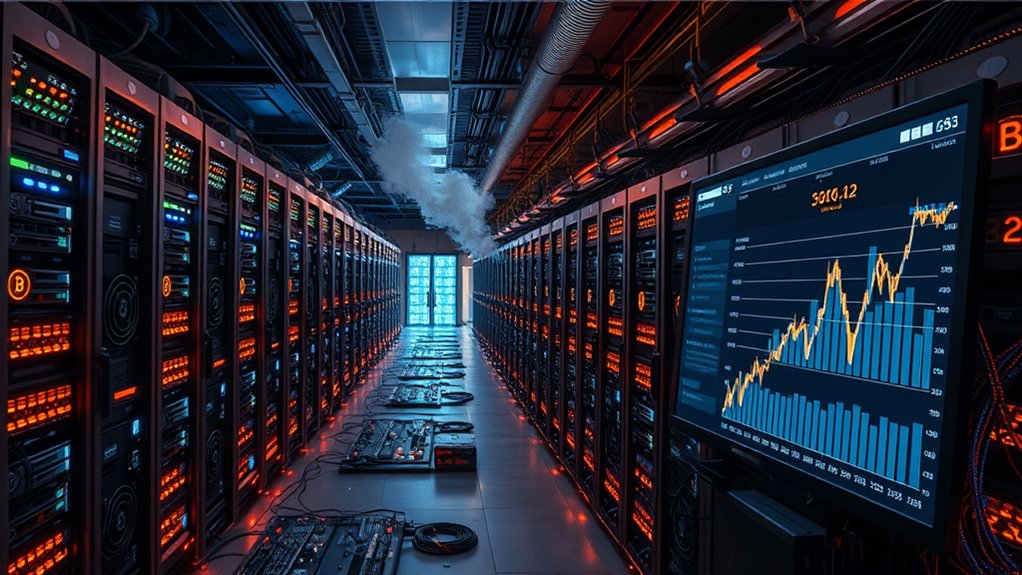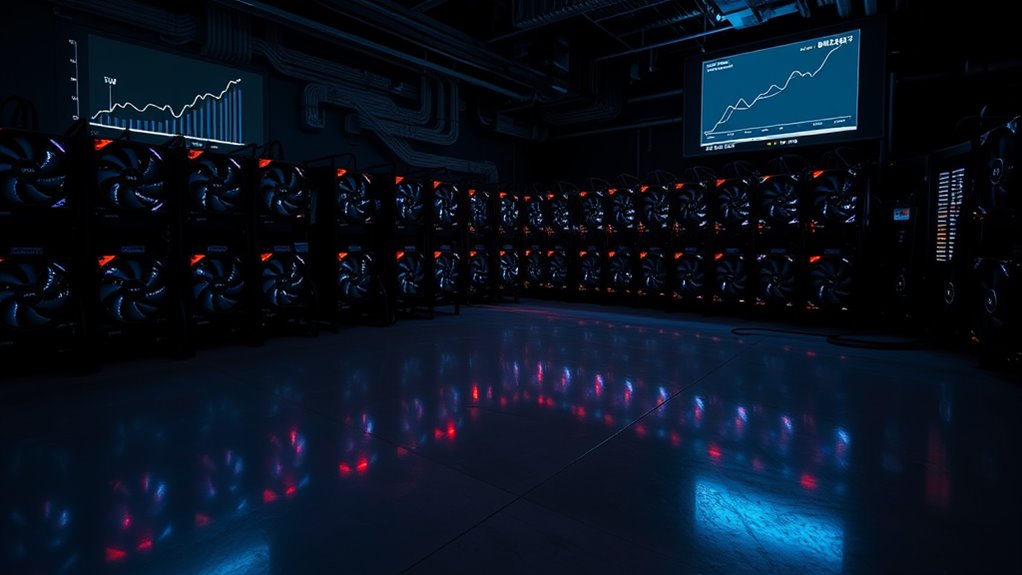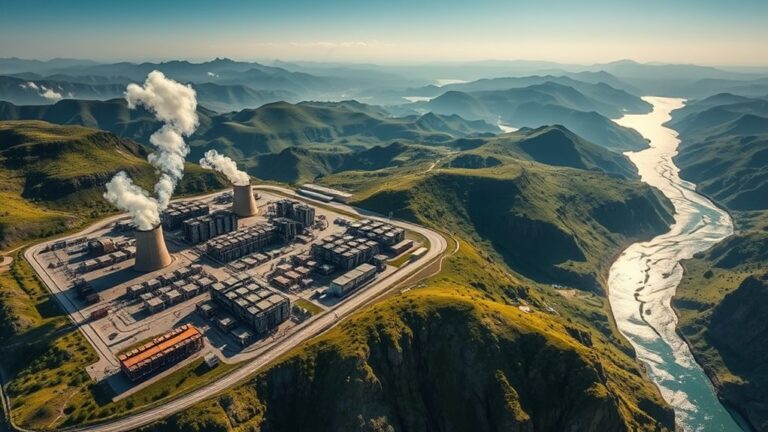
Bitcoin Mining Difficulty: Why It Keeps Increasing
Bitcoin mining difficulty keeps increasing mainly due to heightened competition among miners and technological advancements. As more miners join the network and better hardware, like ASICs, emerges, the computational power grows. This surge in hashing power leads to the adjustment of difficulty every 2,016 blocks. Consequently, miners face lower returns if prices do not rise alongside difficulty. Understanding these underlying factors is essential for grasping the broader implications on the mining landscape and Bitcoin’s future.
Table of Contents
Key Takeaways
- The number of miners increases, raising the overall computational power and consequently the difficulty of solving cryptographic puzzles.
- Advancements in ASIC technology enhance mining efficiency, leading to higher hash rates and increased difficulty.
- Fluctuations in Bitcoin prices attract new miners, which contributes to a competitive environment and rising difficulty levels.
- Regulatory changes and energy costs may influence miner operations, impacting the overall hash rate and difficulty adjustments.
- Periodic adjustments to difficulty every 2,016 blocks ensure network stability and maintain Bitcoin’s capped supply, driving continuous increases in difficulty.
Understanding Bitcoin Mining Difficulty

Understanding Bitcoin mining difficulty is fundamental for grasping how the Bitcoin network operates.
Bitcoin mining difficulty measures the challenge of solving cryptographic puzzles needed to validate new blocks on the blockchain. This system is essential for maintaining network stability, ensuring that blocks are mined approximately every ten minutes.
Bitcoin mining difficulty is crucial for maintaining network stability and ensuring timely block validation on the blockchain.
The difficulty adjusts every 2,016 blocks, or roughly every two weeks, depending on the average time taken to mine those blocks. This adjustment helps to regulate Bitcoin’s predictable inflation rate and its capped supply of 21 million coins.
Miners utilize high computational power, often through specialized hardware known as ASICs, to solve these puzzles. The mining difficulty plays an important role in the overall security and functionality of the Bitcoin ecosystem, as it directly correlates with the Proof of Work mechanism that secures the network against attacks.
Factors Driving Increased Difficulty

Factors driving increased Bitcoin mining difficulty are influenced by several interconnected elements within the network. The number of miners directly affects difficulty; as more individuals join, the total computational power increases, necessitating higher difficulty levels.
Additionally, advancements in mining equipment, particularly ASICs, enhance the network’s hash rate, prompting frequent adjustments. Energy costs also play a role; miners often relocate to areas with cheaper energy, which can maintain profitability despite rising difficulty.
Regulatory changes may force miners to adapt their operations, impacting overall hash rates. Furthermore, fluctuations in Bitcoin prices can attract new miners, further elevating the hash rate and difficulty.
This environment is akin to industrial mining operations, where efficiency and technological advancements are crucial for maintaining competitiveness. Together, these factors create a complex environment that continually influences mining difficulty.
The Impact on Miner Profitability

The increased difficulty of Bitcoin mining has significant implications for miner profitability. As mining difficulty rises, miners face decreased returns if the Bitcoin price and block rewards remain unchanged. A 10% increase in difficulty can lead to a corresponding 10% drop in revenue, impacting the hashprice metric, which measures earnings per unit of hashrate.
Higher difficulty also means more energy is required, raising electricity costs and further affecting profitability. Consequently, less efficient miners may exit the market, potentially restoring profitability for those who remain. To adapt, miners often upgrade their hardware or relocate to areas with lower energy costs, seeking to maintain their competitive edge in a challenging environment. Additionally, miners are increasingly evaluating energy costs to optimize their operations and enhance their profit margins.
Technological Advancements and Their Role

As Bitcoin mining continues to evolve, technological advancements play a crucial role in shaping the landscape of the industry. Increased hash rates from improved Application-Specific Integrated Circuits (ASICs) enhance mining efficiency, resulting in higher difficulty levels.
These advancements in chip technology, shifting to smaller sizes, allow for greater energy efficiency, enabling miners to produce more Bitcoin while consuming less power. Infrastructure improvements, including enhanced networking and cooling systems, also support ideal operations.
Additionally, the integration of machine learning aids in real-time data analysis, improving performance and predicting maintenance needs. Collectively, these innovations drive the industry forward, making mining more efficient while adapting to the increasing challenges posed by rising difficulty levels. Furthermore, the mining process itself is continuously being optimized to accommodate these advancements, ensuring a sustainable future for the industry.
The Future of Bitcoin Mining Difficulty

How will the future of Bitcoin mining difficulty shape the industry?
As mining difficulty continues to increase, driven by a rising hashrate and more miners entering the market, the landscape will become increasingly competitive. This trend necessitates that miners adopt more efficient hardware and energy solutions to maintain profitability.
The periodic adjustments, occurring approximately every two weeks, will additionally challenge miners, especially smaller operations, leading to potential consolidation within the industry.
Furthermore, as energy costs rise, miners may explore renewable sources and diversify into alternative revenue streams.
Ultimately, while increasing difficulty poses challenges, it also enhances the security of the Bitcoin network, potentially fostering greater investor confidence and interest in the cryptocurrency market.
Frequently Asked Questions
How Often Does Bitcoin Mining Difficulty Adjust?
Bitcoin mining difficulty adjusts approximately every 2,016 blocks, which is roughly every two weeks. This adjustment guarantees the network maintains a consistent block time of around 10 minutes, supporting stability and predictable inflation rates.
What Happens if No Miners Participate?
In a world without miners, Bitcoin would resemble a lonely lighthouse, flickering weakly in the dark. Without participation, network security falters, transaction times slow, and trust erodes, threatening the very essence of Bitcoin’s decentralized promise.
Can Mining Difficulty Decrease?
Mining difficulty can decrease under certain conditions, such as reduced hash rates, miner exits, high energy costs, or regulatory changes. These factors collectively lower the computational power needed, making mining more accessible and potentially increasing profitability for remaining miners.
How Is Mining Difficulty Calculated?
Ah, the mystical art of calculating mining difficulty! It’s simply a matter of comparing the highest possible target to the current one, ensuring blocks appear every ten minutes, while keeping miners on their toes.
Does Mining Difficulty Affect Transaction Fees?
Mining difficulty does not directly affect transaction fees. Instead, fees are primarily determined by demand for block space and network congestion, with urgency and competition influencing the amounts users are willing to pay for faster confirmations.
Conclusion
In summary, the increasing difficulty of Bitcoin mining serves as a reflection of the cryptocurrency’s evolving landscape. Various factors such as network growth and technological progress contribute to this trend, shaping the environment for miners. As challenges rise, so do advancements, pushing the boundaries of what is possible. Understanding this cycle is essential for anyone interested in the future of Bitcoin mining, as it highlights the intricate dance between technology and market dynamics in the digital currency domain.



